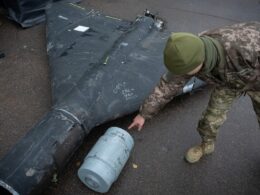Russia is moving electronic warfare (EW) systems 900 kilometers (560 miles) from St. Petersburg to its border with Ukraine to defend against increasing Ukrainian drone strikes, the partisan group Atesh announced. The Russian army appears compelled to redeploy these complexes to counter Ukrainian drones targeting Russian oil refineries, ammunition depots, and other critical military logistics installations at an increasing rate.
Electronic warfare plays an increasingly key role in the ongoing war, as it offers protection from long-range strike drones. According to counter-unmanned systems expert at the Center for European Policy Analysis, Federico Brosari, Ukraine has enhanced its EW systems to target Russian drones, thereby easing pressure on conventional air defenses.

"Agents tracked the movement of a column of the Palantin EW systems, consisting of 7 mobile complexes," Atesh stated.
The Palantin EW system, a critical tool for Russian forces, provides radio-electronic warfare capabilities, including radio intelligence and communication suppression. Moving these systems closer to Ukraine suggests a strategic shift in response to Ukraine’s expanded use of drones.
Ukrainian electronic warfare highlights Russian strategic weaknesses
On 6 November 2024, Ukrainian long-range kamikaze drones struck the port of Kaspiysk, Dagestan – a nearly unprecedented 1500 kilometers (932 miles) deep into Russian territory. Forbes reports, this strike was not the deepest into Russian territory, but that this highlights the vulnerabilities of Russian airspace due to Ukrainian strike capabilities.
On the night of 4-5 November 2024, Ukraine used EW effectively to jam Iranian-designed Shahed kamikaze drones, disabling 27 of 80 drones via EW, according to the Ukrainian Air Force.
On the other hand, to counter Russian use of EW, Ukrainian partisans actively conducted reconnaissance on Russian EW deployments – including complexes stationed in Crimea. Ukraine’s conventional forces also had success in targeting Russian EW infrastructure.

Ukrainian forces were successful in countering Russian EW systems in the past. In footage released on 11 March 2024 by the Special Operations Forces of the Armed Forces of Ukraine, a Ukrainian operation resulted in a High Mobility Artillery Rocket System (HIMARS) strike, neutralizing a system designed to jam FPV drone frequencies.
Such actions highlight Ukraine’s growing capabilities in countering Russian electronic warfare efforts.
Related:
- Ukraine neutralizes 48 Russian Shahed drones, 31 others fail to reach targets; bomb strikes injure two
- Ukraine seizes Russian Volnorez anti-drone EW system with docs in Kursk Oblast
- Frontline report: Ukrainian drones neutralize Russian air defenses, stall offensive near Robotyne
- None of Russia’s 67 Shahed drones managed to hit during overnight attack on Ukraine





